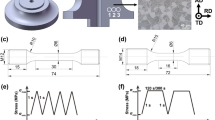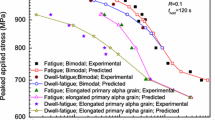Abstract
Many engineering components operate under steady state conditions for a period of time after the peak loads had been achieved. The time during which the loads are near constant is considered dwell time. Materials exhibit sensitivity to dwell times differently to the tension and compression loads and continue to challenge engineers designing such systems. New dwell sensitivity maps proposed in this paper showing the dwell sensitivity behavior of materials in low cycle fatigue (LCF) where life is determined by the development of plastic/inelastic strains and long crack growth (LCG) which is also known as high cycle fatigue life of components. While dwell sensitivity in LCF was significant in lower ranges of strains, higher strains and dwell time did not lower fatigue life as highly as it was under lower strains. LCF dwell sensitivity was predicted with the use of strength ratio, dynamic balance between the hardening and softening, and dwell time damage parameter. Each of these characteristic features predicted dwell sensitivity.
Dwell sensitivity in LCG has not been investigated as widely as in LCF. A new parameter proposed which measures the sensitivity in LCG called, normalized crack growth ratio (NCGR). It was a ratio of crack growth rates under continuous fatigue and dwell fatigue at the same mode I stress intensity factor range. The LCG dwell sensitivity was found from an order-of-magnitude to four orders-of-magnitude. Therefore, the dwell sensitivity was more significant in LCG. Dwell fatigue crack growth mechanism map was generated for Inconel 718 charting various zones in which a particular damage mode was observed. Remaining life assessment performed for a disk component with dwell fatigue crack growth models showed negligible life extension potential under the assumed conditions. There is a need for further collaboration and consensus development defining and/or refining the input parameters.
Access this chapter
Tax calculation will be finalised at checkout
Purchases are for personal use only
Preview
Unable to display preview. Download preview PDF.
Similar content being viewed by others
References
K. G. Wilkinson, Tech Air, 2 (1973) November Issue.
C.A. Stuubington and S. Pearson, Eng. Fracture Mechanics, 10, 4, (1978) 723.
J.H. Fielder and D. Birsch, The DC-10 Case, A study in applied ethics, technology, and society, State University of New York Press, Albany (1992).
Department of Transportation, Federal Aviation Administration, Rule Vol. 63, No. 37, February 25, 1998 pp. 9405–9408, Airworthiness Directives; Pratt and Whitney JT8D Series Turbofan Engines.
S.S. Manson Behavior of materials under conditions of thermal stress; Heat Transfer Symposium, University of Michigan, Engineering Research Institute, Michigan, (1953) pp. 9–75.
L.F. Coffin, Jr. Trans. ASME, 76, (1954), pp. 931–950.
Anon, Code Case N-47, (1976) ASME Boiler and pressure vessel code. Criteria for design of elevated temperature, Class 1 components in Stion III, Division 1, American Society of Mechanical Engineers.
S.S. Manson, G.R. Halford, and M.H. Hirschberg, NASA Report TMX 67838 (1971).
J. Lemaitre, J.L. Chaboche and Y Munakata, Method of metal characterization for creep and low cycle fatigue prediction in structures — Examples of Udimet 700, Proc. Symposium on Mechanical behaviour of materials, Kyoto, Japan, (1973), pp. 239–249.
L.F. Coffin Jr., Fatigue at high temperature and interpretation, Proceedings of Institute of Mechanical Engineers, 9/74, (1974), p. 188.
S. Majumdar, and P.S. Maiya, ASME/CSME Pressure Vessel and Piping Conference, PVP, PB 028, (1978)
W.J. Ostergren, J. Testing and Eval. 4, (1976), pp. 327.
N. Chrzanowski, I, Journal of Mechanical Science, 18, (1976), pp. 69–73.
I.W. Goodall, and D.L. Thomas, Nuclear Electric Inc. Code R-5, (1990)
D.R. Diercks, and D.T. Raskey, A statistical analysis of elevated temperature, strain controlled fatigue data of type SS 304 stainless steel, ASME Annual Winter Meeting, (1976), pp. 1–33.
K. Sonoya,, I. Nonaka, and M. Kitagawa, Prediction of creep-fatigue lives of Cr-Mo steels with Diercks equation, ISIJ International 31, (1991), pp. 1424–1430.
Langer,
S. Vaynman, M.E. Fine and D.A. Jeannotte TMS AIME Annual meeting, Denver, (1987), Ed. by Liaw, P. K. and Nicholas, T.
Plumbridge, W. J. (1996–97) Private communications.
R.H.Stentz, J.T. Berling, and J.B. Conway, AGARD CP 243 1978, paper no. 12
E.G. Ellison, and A.J.F. Patterson, Proc. I. Mech. Engs. 190, (1976), 321
T. Goswami, High Temperature Materials and Processes, 14, (1995), 1,1.
Anon, NRIM Fatigue Data Sheet No. 28, National Research Institute for Metals, (1981) Tokyo, Japan.
Anon, National Research Institute for Metals, Fatigue data sheet No. 62 (1989).
Anon, National Research Institute for Metals, Fatigue data sheet No. 78 (1993).
K. Yamaguchi, and K. Kanazawa, Met. Trans. 11A (1980), 2019.
HJ. Shi, and G. Pluvinage, Int. J. Fatigue, 16, 9, (1994), 549
J.B. Conway, R.H. Stentz, and J.T. Berling, Fatigue, tensile, and relaxation behavior of stainless steels, Technical Information Center, United States Atomic Energy Commission, (1975), pp. 33–81.
G.R. Halford, L.R. Johnson, and J.A. Brown, High temperature LCF of Ni-201 and 304L S.S., NASA Conference Publication 2437, Advanced Earth-to-Orbit Propulsion Technology, Ed. R. J. Richmond and S. T. Wu, (1986), 172.
J.M. Drapier, and M.H. Hirschberg, AGARD AR 130, (1979).
W.J. Plumbridge, and M. Stanley, Int. J. Fatigue, 8, (1986), 209.
K.D. Sheffler and G.S. Doble, Influence of creep damage on the low cycle thermal-mechanical fatigue behavior of two tantalum base alloys, (1972), NASA-CR-121001.
V.T.A. Antunes and P. Hancock, AGARD CP 243, paper no. 5, (1978)
E.G. Ellison, W.J. Plumbridge and M.S. Dean, Research Report 327, University of Bristol, Department of Mechanical Engineering, (1984).
G. Asquith, and S.H. Springthall AGARD CP 243, (1978), paper no. 7.
J.M. Hyzak and H.L. Bernstein AGARD CP 243, (1978), paper no. 11.
C.S. Kortovitch and A.A. Sheinker, AGARD CP 243, (1978), paper no. 1.
K.B. Rao, H.P. Meurer and H. Schuster, Mater. Sci. Engng. A104, (1988), 37
G.R. Halford and A.J. Nachtigall, AGARD CP 243, (1978), paper no. 2.
R.V. Miner, J. Gayda and M.G. Hebsur, ASTM STP 942, (1988), 371
G.A. Swanson, I. Linask, D.M. Nissley, P.P. Norris, T.G. Meyer, and K.P. Walker, Life prediction and constitutive models for engine hot stion anisotropic materials program, NASA-CR-179594, (1987).
T. Goswami, T. High Temperature Materials and Processes, 15, 1–2, (1995), 91–96.
H.G. Edmund and D.J. White Observations of the effect of creep relaxation on high strain fatigue, J. Mech. Eng. Sci. 8, (1966) pp. 310–321.
Y. Wada, Y. Kawakami, and K. Aoto, A statistical approach to fatigue life prediction for SUS 304, 316, and 321 austenitic stainless steels, Thermal stress, material deformation, and thermo-mechanical fatigue, ASME PVP 123, ed. H. Sehitoglu and S. Y. Zamrik, (1987), pp. 37–42.
T. Goswami, Dwell sensitivity modeling — a new damage parameter, Materials and Design 25, 3, (2003), 191–197.
T. Goswami and H. Hanninen, Dwell effects in high temperature fatigue behavior, paper I, Materials and Design, 22, 3, (2001), 199–215.
T. Goswami and H. Hanninen, Dwell effects in high temperature fatigue damage mechanisms Paper II, Materials and Design, 22, 3, (2001), 217–236.
T. Goswami, Dwell Sensitivity, Part I Behavior and Modeling, Mechanics of Materials 22, 2, (1996), 105–130.
T. Goswami, Low cycle fatigue — dwell effects and damage mechanisms, International Journal of Fatigue, 21, 1, (1999), 55–76.
T. Goswami and G.F. Harrison, Gas turbine disk lifing philosophies — a review, International Journal of Turbo and Jet Engines 12, 1, (1995), 59–77
M Hörnqvist, T. Mânsson and D. Gustafsson, High temperature fatigue crack growth in Alloy 718 — Effect of tensile hold times, Procedia Engineering, 10, (2011), 147–152.
H. Andersson, C. Persson, and T. Hansson, Crack growth in IN718 at high temperature, International Journal of Fatigue, 23, 9, (2001) 817–827.
J. Moverare and D. Gustafsson, Hold-time effect on the thermo-mechanical fatigue crack growth behaviour of Inconel 718. Materials Science & Engineering A, 528 (29–30), (2011), 8660–8670.
J.P Pédron, and P. Pineau, The effect of micro structure and environment on the crack growth behavior of Inconel 718 alloy at 650°C under fatigue, creep and combined loading, Materials Science and Engineering, 56, 2, (1982), 143–156.
D. Gustafsson, J.J. Moverare, S. Johansson, K. Simonsson, M. Hörnqvist, , T. Månsson, and S. Sjöström, Influence of high temperature hold times on the fatigue crack propagation in Inconel 718. International Journal of Fatigue, 33 (11), (2011), 1461–1469.
R.J.H Wanhill, Significance of dwell cracking for IN718 turbine discs, International Journal of Fatigue, 24 (5), (2002), 545–555
R. Tobler, Low temperature effects on the fracture behaviour of a nickel base superalloy. Cryogenics, 16 (11), (1976), 669–674.
J.A. Lee, The effect of grain size upon the fatigue-crack propagation behavior of alloy 718 under hold-time cycling at elevated temperature, Engineering Fracture Mechanics, 25, 3, (1986), 305–314.
M. Soboyejo, and C. Soboyejo, Micromechanisms of fatigue crack growth in a forged Inconel 718 nickel-based superalloy, Materials Science and Engineering: A, 270 (2), (1999), 308.
O. Osinkolu, and G. Marchionni, Fatigue crack growth in polycrystalline IN 718 superalloy, Materials Science and Engineering: A, 356 (1–2), (2003), 425
B.K. Duckett and T. Goswami, Dwell sensitivity in long fatigue crack growth and prediction model, internal memorandum, also submitted to International Journal of Fatigue (2012).
J.A. Carter, M. Thomas, T. Goswami, and T. Fecke, Probabilistic risk assessment of a turbine disk, in the proceedings of International Symposium on Fatigue of Materials II: Advances and Emergences in Understanding, MST, October 2012, edited by Dr. Ashraf Imam, Dr. T.S. Srivatsan and Dr. Raghavan Srinivasan, published by The Minerals, Metals and Materials Society.
J.A. Carter, T. Goswami and T. Fecke, Probabilistic risk assessment for life extension of turbine engine rotors, submitted to Materials and Metallurgical Transactions (2012).
M.A. Thomas, J.A. Carter, L. Matson, T. Goswami, A. Whitney-Rawls and T. Fecke, Feature based discretization of a turbine disk for probabilistic risk assessment, submitted to ASME Journal of Gas Turbine and Power (2012).
X. Ma, Z. Duan, H. Shi, R. Murai, and E. Yanagisawa, Fatigue and fracture behavior of nickel based superalloy Inconel 718 up to the very high cycle regime, Journal of Zhejiang University — Science A (Applied Physics and Engineering) 11, 10, (2010), 727–737.
S. Suresh, Fatigue of Materials, Cambridge University Press, Cambridge, 1998).
Author information
Authors and Affiliations
Editor information
Editors and Affiliations
Rights and permissions
Copyright information
© 2013 TMS (The Minerals, Metals & Materials Society)
About this chapter
Cite this chapter
Goswami, T. (2013). Dwell Fatigue Design Criteria. In: Srivatsan, T.S., Imam, M.A., Srinivasan, R. (eds) Fatigue of Materials II. Springer, Cham. https://doi.org/10.1007/978-3-319-48105-0_5
Download citation
DOI: https://doi.org/10.1007/978-3-319-48105-0_5
Publisher Name: Springer, Cham
Print ISBN: 978-3-319-48583-6
Online ISBN: 978-3-319-48105-0
eBook Packages: Chemistry and Materials ScienceChemistry and Material Science (R0)




